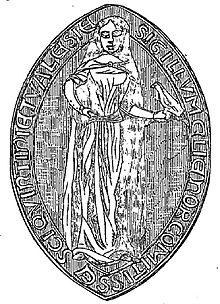Eleanor, Countess of Vermandois
| Eleanor | |
|---|---|
 |
|
| Countess of Vermandois | |
| Spouse(s) | Godfrey of Hainaut William IV, Count of Nevers Matthew, Count of Boulogne Matthew III, Count of Beaumont |
| Noble family | Capetian House of Vermandois |
| Father | Ralph I, Count of Vermandois |
| Mother | Petronilla of Aquitaine |
| Born | 1148/1149 |
| Died | 19 June or 21 June 1213 |
| Buried | Aisne, France |
Eleanor of Vermandois also known as Eléonore de Vermandois (1148 or 1149 – 19 or 21 June 1213) was ruling Countess of Vermandois in 1182-1213, and Countess consort by marriage of Ostervant, Nevers, Auxerre, Boulogne and Beaumont. She was a daughter of Ralph I, Count of Vermandois and his second spouse Petronilla of Aquitaine.
Eleanor was the youngest of three children born to her father by his second marriage. Eleanor's two older siblings were Ralph II, Count of Vermandois and Elisabeth, Countess of Vermandois. She had an older half-brother from her father's first marriage: Hugh II, Count of Vermandois. A couple of years after the birth of Eleanor, her parents divorced; her father remarried to Laurette of Flanders in 1152 but died later that same year.
At the time of her birth, Eleanor was fourth in line to inherit the Vermandois title so therefore was not expected to inherit with two older brothers and a sister ahead of her in the line of succession.
Eleanor was married firstly in her mid-teens to Godfrey of Hainaut, Count of Ostervant, heir to his father Baldwin IV, Count of Hainaut. The couple married in 1162, however, Godfrey died the following year, whilst preparing for a journey to Palestine.
Her second marriage in 1164 was to William IV, Count of Nevers; this marriage was also brief lasting only four years when William died at Acre in 1168 on crusade.
A third marriage occurred in 1171 between Eleanor and Matthew, Count of Boulogne, who had divorced his first wife Marie, Countess of Boulogne the previous year. This marriage produced Eleanor's only child, a short lived daughter. No further children could be born as Matthew died in 1173 whilst fighting at the siege of Trenton (now Neufchatel-en-Bray); he was shot by an archer wielding a crossbow.
...
Wikipedia
